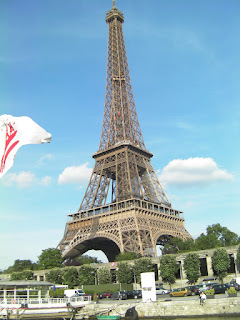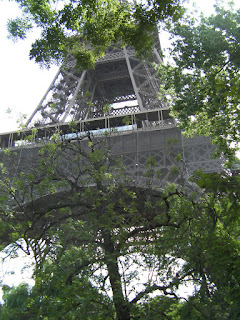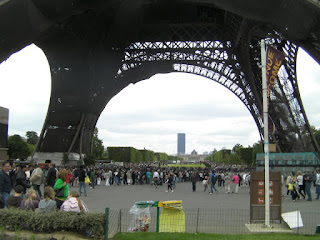Category: Kristine Hughes
Paris – Beyond the Eiffel Tower
Yes, Virginia, There is an Eiffel Tower
 Okay, alright, I admit it – the Eiffel Tower exists. And I became as enthralled by it as everyone else, as evidenced by the multitude of photos included here. Brooke and I were allowed only a fleeting glimpse of the Tower during our taxi ride to the hotel. Next day, we boarded one of those hop on, hop off, double decker tourist buses and set off on a tour of Paris. At one point, we rounded a corner and there, in all it’s glory, was the Eiffel Tower. As Brooke remarked, actually seeing it in person, and rather unexpectedly, takes your breath away. These are photos from my camera – and I hardly took any snaps at all, leaving the bulk of that duty to Vicky and Brooke. I can only imagine how many images of the Tower Brooke has on her camera. Without a doubt, we have 360 degree views of the Tower. From every angle. At any time of day or night. Wallpaper anyone? As promised in my previous post concerning the Eiffel Tower, I apologise to the French people for ever doubting it’s existence.
Okay, alright, I admit it – the Eiffel Tower exists. And I became as enthralled by it as everyone else, as evidenced by the multitude of photos included here. Brooke and I were allowed only a fleeting glimpse of the Tower during our taxi ride to the hotel. Next day, we boarded one of those hop on, hop off, double decker tourist buses and set off on a tour of Paris. At one point, we rounded a corner and there, in all it’s glory, was the Eiffel Tower. As Brooke remarked, actually seeing it in person, and rather unexpectedly, takes your breath away. These are photos from my camera – and I hardly took any snaps at all, leaving the bulk of that duty to Vicky and Brooke. I can only imagine how many images of the Tower Brooke has on her camera. Without a doubt, we have 360 degree views of the Tower. From every angle. At any time of day or night. Wallpaper anyone? As promised in my previous post concerning the Eiffel Tower, I apologise to the French people for ever doubting it’s existence. Back in the U.S. of A
Kristine here, back in the land of television shows in English and computer keyboards with all the keys where they should be. I did try to post while in France, but honestly, it was too frustrating. As Vicky has posted, once she is also back in the States we’ll be posting blogs and pics of our trip, but for now I’ll give you the highlights of the Wellington tour once Vicky and I parted ways. Vicky and Ed left us on Sunday morning, Battle of Waterloo day, in order to make their cruise connection. Brooke and I went on with the tour to the re-enactment site.
When we’d visited the day before to see the military camps, La Belle Alliance and Hougemount, someone had asked me if I were going to walk to the top of the Lion’s Mound, the great man-made hill erected to commemorate the Battle and I responded, emphatically, no. It’s an almost verticle hill with many, many steps to the top. Well, dear reader, never say never. It turns out that there were so many visitors to the battle that if you’d stayed on the ground, you’d never see a thing, being five or six deep in a crowd of spectators. It was absolutely freezing on the day, and had rained the day before so Brooke and I bought commemorative Waterloo blankets (not kidding) and began the long climb up the mound. We got about half way there and found ourselves spots from which to view the action. Once you left the stairs, you had to crouch down in order to walk to your place, the slope is so steep. Also, it’s covered in slippery grass, with no footholds to speak of. Talk about harrowing. Brooke later told me that she’d never before actually seen terror in anyone’s eyes as she had when she was helping me to our place. The fact that people above us kept losing their personal items – cameras, umbrellas and such – and that these kept rolling down the hill past us did not offer us much comfort. At last we found purchase, digging our heels and butts into the hillside in order to gain a bit of purchase, and settled in for the show. . .
And what a show it was. It was absolutely thrilling to be in the thick of the Battle, so to speak. The formations, the cannons going off, the rifles being fired, the smoke enveloping the field as mounted calvary cantered across the field, all of it was fabulous. And to add to the authenticity of the thing, it began to bucket down rain. So now I’m precariously perched on the side of the Mound, watching the battle, holding an umbrella over us and trying to film the Battle. It was at this point that Brooke told me she wasn’t into Wellington as much as I was and this was all more of a sacrifice than she was prepared to make and that she was going down the pub to wait for me in the dry, with a drink. Thank God one of fellow tour members, an exceedingly nice man who was a retired police detective from Surrey, was with us and able to help me back down the Mound at the end or I’d still be sitting at the Battlefield.
Vicky and I took masses of photos all along the way and we promise to post them soon – shots of the military camps, the battle sites and lots of re-enactors in various uniforms. I also took much video – including footage of “Wellington” on horseback, galloping between regiments – and if I can figure out how to edit these, I’ll be posting them in the near future. It’s grand to be back and we look forward to sharing our trip via our posts here soon.
A London Whirlwind
Kristine here – No doubt this post will read as though I’ve been doing crack for the past week, but I’ve so much to tell you that I’m just going to go for it and spit it out, disjointed or no. Apsley House was our first stop – Yippeee! From there on, there’s so much that’s happened that it’s all running together. Walked down Picadilly to St. James’s Street (paid hommage to White’s Club), went to a veddy British concert in St. Martin’s in the Fields, strode past the Horse Guards and discovered that Wellington’s Office, still preserved, is not generally open to the public, so I’ll have to write in advance for admittance next time I come over. Sunday was our garden walk day, which we fit in between going to the National Army Museum (saw the saw used to amputate Angelsey’s leg, and the surgeon’s bloody glove), went to the Grenadier Pub for dinner with Carrie Bebris and her dad. Yes, ladies, I went back into the mews where the ghosts were previously seen, but it being light here till about 10 p.m., saw none.
On Monday we went to Cecil Court and Charing Cross Road for bookshopping Saw a lovely Staffordshire figure of the Duke in an antique store, but shop wasn’t yet open. Bought gorgeous color print of the Duke and then we walked to Grosvenor Prints in Seven Dials and Vicky bought two fashion prints, while I bought an invitation issued by the Duke from Aspley House. On to Gray’s Antiques market, where I found another color print of the Duke sitting on a bench with another man, whom I don’t recognize and which will require further research. Went to Lansdowne Club for drinks then on to dinner at Just St. James, in St. James’s Street.
Tuesday to Windsor to see Hester Davenport, who asked us as we left the station if we wanted to see the Queen – as if there’s a really a question. Of course we said yes, so at 1:30 we went over to the long drive and watched their cars leaving the Castle – saw the Queen, Phillip, Andrew and I was waved to by Camilla. NO sight of Chuck – rats. Had a fabulous day with Hester, who took us back to her home for tea and showed us the original Vauxhall prints she has on her walls. Gorgeous.
Yesterday I went to the Museum of London, and to Hampstead to see Kenwood House and the portrait of the Brummell brothers. Back to London to walk and shop in Oxford Street. Then off to Leicester Square and China Town for duck. On the way, we again passed Cecil Court and this time the only shop that was still open happened to be the one with the Wellington figure in the window. In we went . . . Oh, boy, was I a bad girl. Once the proprietors learned of my interest in the Duke we were given brandy and fags and had a good chin wag about other Wellington collectors they know, including the present D of W, who had just been in the shop on the Saturday. Yes, the Duke collects Artie-Facts, too! As if he hasn’t enough already. Well, I’m on my way to catching up with him – bought a brass wall plaque, the Duke’s profile, a quite sizeable memorial coin, a pot and pot lid depicting the Duke riding at Stratfield Saye and . . . the really very large Staffordshire figurine of the Duke I’d seen in the window. It’s going to look smashing on my mantle. I hate to think what my husband will say when all these packages begin arriving at home . . . . Oh, well, the Wellington Museum collection is growing.
No concrete plans for today except walking London with Brooke and perhaps lunch at the Duke of Wellington at Waterloo pub (it’s near Waterloo tube station). Waterloo is still ahead for us and we’re all chomping at the bit to get there. I do hope there are as many flower sellers in Brussells as there are in London, so that I can buy a bouquet to leave at the Battlefield.
Vicky and I have lots of photos to post when we get home, and video of the Queen’s procession, and we’ve been thinking of you all at every turn. More in-depth posts on what’s already been briefly touched upon when we return. Cheers!






